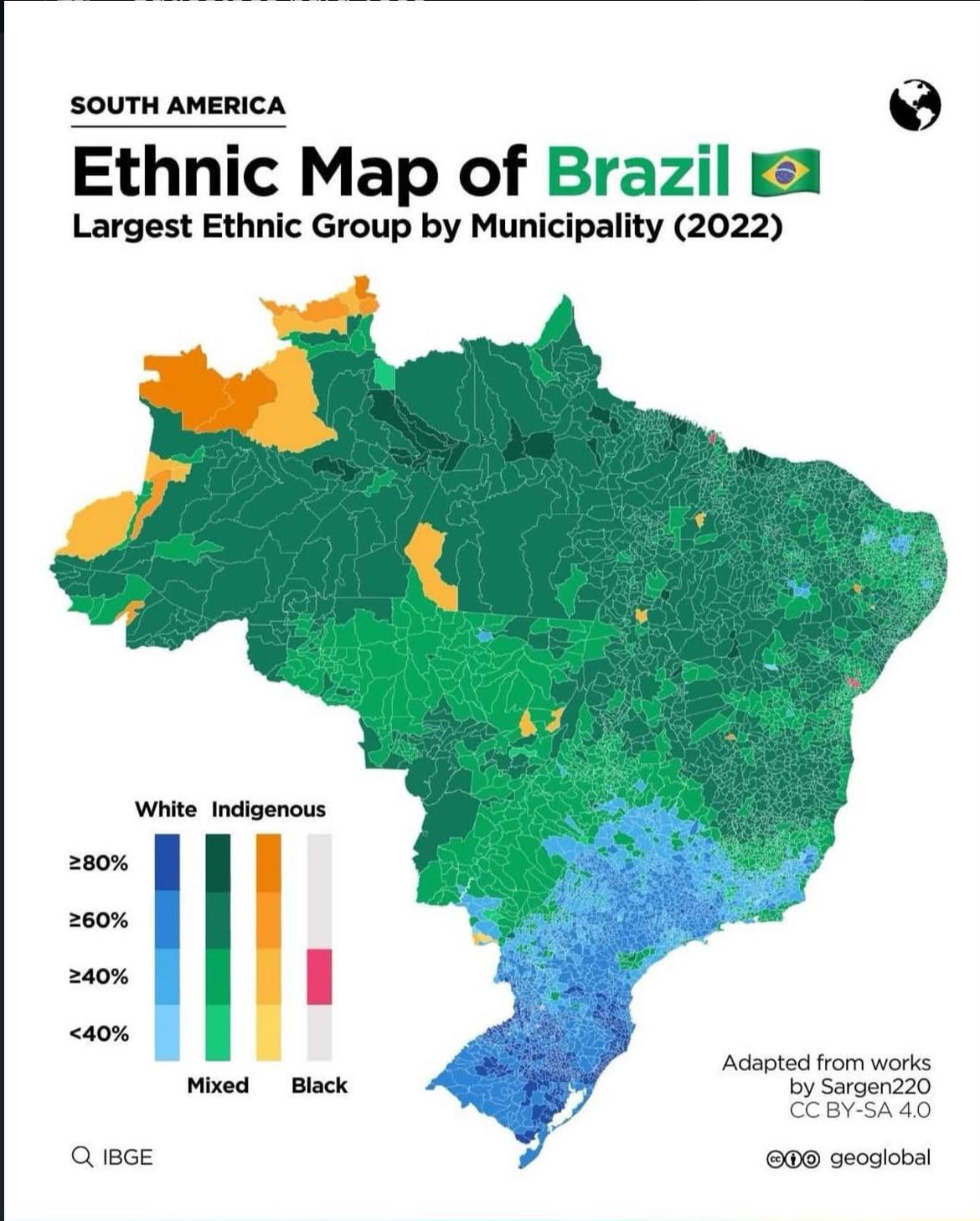Ethnic Diversity Map of Brazil


David Chen
Data Visualization Specialist
David Chen is an expert in transforming complex geographic datasets into compelling visual narratives. He combines his background in computer science ...
Geographic Analysis
What This Map Shows
The "Ethnic Map of Brazil" presents a vivid representation of the country’s remarkable ethnic diversity. Brazil's population is a fascinating tapestry woven from various racial and ethnic threads, including pardos (mixed race), whites, blacks, indigenous peoples, and Asians. The map allows us to visualize how these groups are distributed across Brazil, providing insight into the cultural and demographic landscape of one of the largest countries in the world.
Deep Dive into Brazil's Ethnic Composition
Brazil's ethnic makeup is one of the most diverse globally, and understanding this composition gives us a clearer picture of the nation's identity and social fabric. According to the latest data, pardos, or mixed-race individuals, make up 45.3% of the population, which translates to approximately 92.1 million people. This group is often highlighted in red on maps to signify its significant presence. Interestingly, the term "pardo" refers to individuals with tri-racial ancestry, often combining European, African, and Indigenous roots. This diversity leads to a wide range of phenotypes, meaning individuals within this group can appear in various forms, which is a hallmark of Brazil's complex racial history.
Whites constitute the second-largest demographic at 43.5%, amounting to about 88.2 million individuals. This group primarily descends from European immigrants who arrived in waves, especially during the 19th and early 20th centuries. The remaining population is composed of blacks (10.2% or approximately 20.6 million), indigenous peoples (0.8% or around 1.7 million), and Asians (0.4% or about 850,000).
Interestingly, many Brazilians hold the belief that Brazil has the largest population of black people outside Africa. However, this title currently belongs to the United States, where around 47 million people identify as black. This misconception highlights how ethnicity and identity can be perceived differently in various contexts.
The pardo classification can sometimes blur racial lines, as seen in the case of famous Brazilian footballer Neymar and his son. While Neymar identifies as pardo, his son, who appears white and blonde, still falls under the pardo classification due to his father's heritage. This nuance showcases the complexity of racial identity in Brazil, reflecting the country’s historical blend of cultures and ethnicities.
Regional Analysis
Examining Brazil's ethnic map reveals significant regional variations in demographic composition. For instance, in the Northeast, where the African influence is historically more pronounced due to the transatlantic slave trade, you’ll find a higher concentration of black and pardo populations. In states like Bahia, which is known for its rich African heritage, the black population is notably higher than in other regions.
Conversely, in the South, states like Rio Grande do Sul exhibit a larger percentage of individuals identifying as white, reflecting the area’s European immigrant history. The Southeast region, including major urban centers like São Paulo and Rio de Janeiro, showcases a melting pot of ethnicities, where mixed-race individuals are prevalent alongside whites and blacks. This diversity is particularly evident in urban settings, where cultural exchanges and interactions flourish.
Moreover, the Indigenous population, though small at 0.8%, is concentrated in specific areas, primarily in the Amazon region, where many tribes maintain their traditional lifestyles. The presence of indigenous peoples is essential for understanding Brazil's cultural history and the ongoing dialogues about land rights and environmental conservation.
Significance and Impact
Understanding Brazil's ethnic diversity is crucial in addressing social issues, including inequality, representation, and cultural heritage. The country's racial dynamics can influence everything from politics to economic opportunities and social interactions. For instance, the pardo population often faces unique challenges related to identity and recognition in a society that still grapples with the legacies of colonialism and slavery.
What's fascinating is that this diversity is not just a statistical reality; it has real-world implications for policy-making and social cohesion. As Brazil continues to evolve, discussions about race and ethnicity are becoming increasingly important, especially as movements for social justice gain momentum. The ethnic map serves as a reminder of the country's rich history and the ongoing journey toward equality and inclusion.
In conclusion, the "Ethnic Map of Brazil" is not just a depiction of numbers; it represents a vibrant and complex society that continues to shape its identity. As Brazil moves forward, understanding and embracing this diversity will be essential in fostering a more inclusive future for all its citizens.
Visualization Details
- Published
- August 16, 2025
- Views
- 128
Comments
Loading comments...